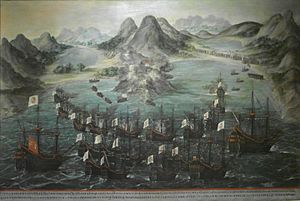Capture of Saint Martin (1633)
| Capture of Saint Martin | |||||||
|---|---|---|---|---|---|---|---|
| Part of the Eighty Years' War | |||||||
 Spanish capture of Saint Martin by Juan de la Corte (1597-1660), oil on canvas. Naval museum of Madrid | |||||||
| |||||||
| Belligerents | |||||||
|
|
| ||||||
| Commanders and leaders | |||||||
|
|
| ||||||
| Strength | |||||||
|
24 men-of-war 31 transports 1300 men | |||||||
| Casualties and losses | |||||||
|
3 ships captured[2] 77~100 prisoners[3] | Low | ||||||
Part of the Eighty Years' War, the Capture of Saint Martin was a Spanish naval expedition against the island of Saint Martin occupied by the Dutch Republic and administered as part of the Dutch Antilles. The island, claimed by Spain since Christopher Columbus' second voyage to the West Indies in 1493, lies a few hundred miles east of Puerto Rico. The capture eliminated the presence of Dutch privateers in the island, weakening Dutch privateering and commerce in the Caribbean.
Action
The Spanish reconnaissance revealed that Dutch settlers had a 22-gun fortress covering Sint Maarten's approaches, so admiral Cadereyta sent an emissary ashore from the Spanish flagship Nuestra Señora de Aranzazu, to demand the garrison's surrender.[4] Approximately 150 Dutch defenders and 40 black auxiliaries under Jan Claeszoon van Campen rejected Cadereyta's overture. As a result several Spanish galleons engaged the fortress in a heated fire exchange during which seven Spanish sailors perished while their boats were disembarking.[5] At 2:00 A.M in the next day, 1,000 troops and 300 sailors were set ashore under Vice admiral de Hoces and Maestre de Campo Luis de Rojas y Borgia with who small field cannons. They made an arduous march through the jungle, suffering at least six deaths from heat exhaustion before finally emerging behind the Dutch fortress and storming its walls on 26 June. Musket fire halted them, with de Hoces receiving a crippling wound in his left elbow and side. The Spaniards inaugurated formal siege proceedings, bringing ashore four heavier guns to install in a battery, and then launched another 100-man assault the night of 28 June during which the veteran naval captain Tiburcio Redín was injured.[6]
Aftermath
On 1 July, a badly wounded van Campen and his 62 Dutch and 15 black survivors requested terms for their surrender, which were granted.
Cadereyta occupied the fortress the next day, deciding to keep it for Spain and strengthen its defenses by adding four 24-pounders, four 18-pound demi-culverins, and five 12-to ten-pounders to its armament, plus a permanent garrison of 250 Spanish soldiers and 50 auxiliaries under Captain Cebrián de Lizarazu.[7] The Spanish fleet then sailed to San Juan de Puerto Rico, arriving with its prisoners and three Dutch prize ships on 13 July. The Spaniards allowed all inhabitants to leave, hoisted the Spanish flag and read a Holy mass of Gratitude in the fort.[8]
Spain formally returned the island to the United Provinces at the Munster peace treaty.[9]
References
Bibliography
- Lane, E Kris. Pillaging the Empire: Piracy in the Americas 1500-1750. M.E. Sharpe Publishers, ISBN 0-7656-0257-1
- David F. Marley. Wars of the Americas: A Chronology of Armed Conflict in the New World, 1492 to the Present ABC-CLIO(1998) ISBN 0-87436-837-5
- Dewald, Jonathan. Europe 1450 to 1789: Encyclopedia of the Early Modern World Publisher:Charles Scribners & Sons(2003) ISBN 0-684-31200-X
- Hartog, Johannes History of Sint Maarten and Saint Martin
